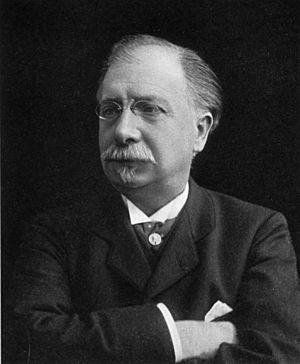Gilbert Ballet facts for kids
Gilbert Ballet (born March 29, 1853 – died March 17, 1916) was an important French doctor. He was a psychiatrist, which means he helped people with mental health issues. He was also a neurologist, studying the brain and nervous system, and a historian. He was born in a town called Ambazac in France.
Contents
Early Life and Education
Gilbert Ballet studied medicine in two famous French cities: Limoges and Paris. After finishing his studies, he worked with a very famous doctor named Jean-Martin Charcot (1825–1893) at the Salpêtrière hospital. Ballet became a "Chef de clinique" there, which means he was a senior assistant doctor helping with patient care and teaching.
Career and Achievements
In 1900, Gilbert Ballet became a professor of psychiatry, teaching students about mental health. A few years later, in 1904, he started a new psychiatry department at the Hôtel-Dieu de Paris hospital. This was a big step in how mental health was treated in France.
In 1909, he took over from Alix Joffroy as the head of clinical psychiatry and brain disorders at the Hôpital Sainte-Anne. That same year, he was chosen to be the president of the Société française d'histoire de la médecine, a group that studies the history of medicine in France. In 1912, he became a member of the Académie des sciences, which is a very respected group of scientists in France.
Important Contributions to Psychiatry
Gilbert Ballet is well-known for a book he published in 1903 called Traité de pathologie mentale. This book was a main reference for doctors studying psychiatry in France for almost 50 years.
In 1911, Ballet described a mental health condition he named psychose hallucinatoire chronique. This condition involves long-lasting delirium (a state of confusion with strange beliefs) and mainly hallucinations (seeing or hearing things that are not real). In French psychiatry, this "chronic hallucinatory psychosis" became known as a specific condition, different from other disorders where people have false beliefs.
Other Notable Works
Ballet wrote several other important books and papers. In 1888, he published Le Langage Interieur et les Diverses Formes de l'Aphasie. This book was about how people use "inner speech" (talking to themselves in their minds) and different types of aphasia (difficulty with language).
In 1897, he wrote a book called Psychoses et affections nerveuses. This book discussed conditions like hypochondria (worrying too much about being sick) and paranoia (feeling like others are trying to harm you). He also wrote a historical biography about the philosopher Emanuel Swedenborg, titled "Swedenborg; histoire d'un visionnaire aux XVIIIe siècle".
With another doctor named Adrien Proust, he published L'Hygiène du neurasthénique. This book was later translated into English as "The Treatment of Neurasthenia" and offered advice on how to manage fatigue and weakness.
Associated Medical Term
- Ballet's sign: This is a medical term named after Gilbert Ballet. It describes a type of palsy (weakness or paralysis) that affects one or more of the muscles around the eye. It is often seen in people with Graves' ophthalmopathy, an eye condition linked to an overactive thyroid gland.
See also
 In Spanish: Gilbert Ballet para niños
In Spanish: Gilbert Ballet para niños
- A Clinical Lesson at the Salpêtrière


